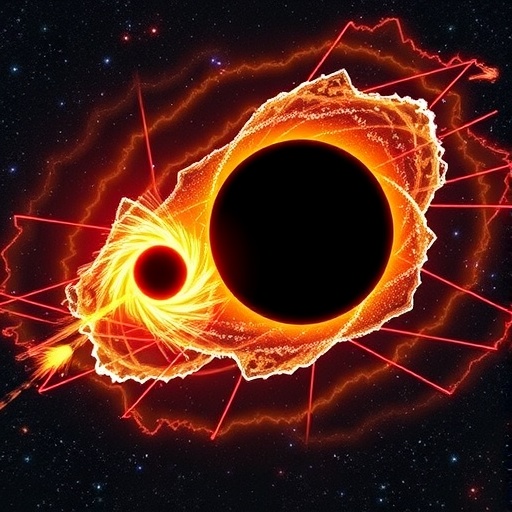In a groundbreaking study published by Kyutoku, Shibata, and Taniguchi in 2021, the complex phenomena surrounding the coalescence of black hole-neutron star binaries have come into sharper focus. The immense gravitational forces and relativistic effects when these celestial bodies merge lead to some of the universe’s most violent and fascinating events. By employing detailed simulations and innovative theoretical frameworks, the researchers shed light on the intricate processes involved in such cosmic collisions, thereby providing invaluable insights into gravitational wave astronomy.
The coalescence of black hole-neutron star binaries is pivotal for our understanding of the universe’s evolution and the fabric of spacetime itself. These events are not merely about two celestial entities colliding; they represent a convergence of stellar evolution, gravitational physics, and the extreme environments that emerge from such cataclysmic events. As these two dense objects spiral towards each other, they emit gravitational waves—a form of radiation that flows through the cosmos, rippling the very fabric of spacetime.
The study emphasizes the significance of gravitational waves as messengers from the cosmos, offering a new means to observe phenomena that are otherwise invisible to traditional optical telescopes. The coalescence of black holes and neutron stars has been a specific area of focus due to the distinct signatures they produce, enabling scientists to distinguish between different types of events. This has profound implications not only for astrophysics but also for our understanding of fundamental physics under extreme conditions.
As the binaries orbit each other, they lose energy through the emission of gravitational waves, causing them to spiral inward until their inevitable collision. The detail and precision with which the researchers modeled this process reveal not just the paths these celestial bodies take but also the physical conditions that prevail in such extreme environments. Understanding the dynamics of these systems helps scientists decode the nature of the substances within neutron stars, which are thought to contain exotic forms of matter.
The implications of black hole-neutron star mergers extend far beyond mere observation. These events are believed to be sites where heavy elements like gold and platinum are synthesized through rapid neutron capture processes. This has led to significant discussions about the origins of heavy elements found on Earth and throughout the cosmos. The research highlights how harnessing gravitational wave data allows us to probe these extraordinary processes and broaden our understanding of nucleosynthesis in the universe.
Moreover, the study also delves into the gravitational signatures that these systems emit. A recent surge in gravitational wave detections by observatories like LIGO and Virgo has transformed our observational landscape. With predictions and models re-invigorated by this ongoing research, scientists can now attribute detected gravitational wave signals to specific types of merging events, paving the way for more robust astrophysical theories. Each detection not only enriches our knowledge of such mergers but also validates the general theory of relativity under extreme conditions.
Notably, the research team employed cutting-edge numerical simulations to model the dynamics of coalescing binaries effectively. By leveraging supercomputing resources, they crafted intricate simulations that detail various parameters of the binary systems—such as masses, spins, and the resulting neutron star remnant. The results of these simulations provide a critical framework for interpreting observational data and developing our theoretical understanding of these cosmic phenomena.
The merger process is also accompanied by the emission of electromagnetic radiation across various wavelengths. The study contributes to the ongoing efforts to unify gravitational and electromagnetic observations. As we observe the afterglow of these massive mergers, we piece together the events that transpired during and immediately after the coalescence, enhancing our understanding of the evolutionary paths taken by stars in our universe.
Additionally, the research has implications for the concept of black hole spins and their configurations when merging with neutron stars. The interplay between the spin of these densely packed objects influences the gravitational waveforms generated during the coalescence and affects the mechanisms that govern their final outcomes. This understanding can refine models that predict the characteristics of the signals produced by mergers, which is of great value for future observations.
As investigations deepen into the realms of gravitational wave astronomy, the work of Kyutoku, Shibata, and Taniguchi signifies a leap towards developing a comprehensive picture of the universe’s most violent events. The interplay of theory, simulation, and observational data forms a triad that enhances our ability to decipher the mysteries encased within these cosmic mergers.
The collaboration between theorists and observational experts underscores the interdisciplinary approach required to tackle such complex problems. The research not only connects astrophysics but also intersects with areas like particle physics, cosmology, and even information theory, reflecting a growing consensus on the need to understand gravitational phenomena from multiple angles.
In summary, as we continue to observe the cosmos and compile data on black hole and neutron star mergers, each revelation contributes to our broader comprehension of fundamental physics. The emerging understandings, as documented by Kyutoku and his colleagues, pave the way towards a unified theory of gravity, challenging our pre-existing notions of spacetime and pushing the boundaries of modern astrophysics.
As we stand on the cusp of new discoveries in gravitational-wave astronomy, the research showcased in this seminal paper exemplifies the critical nature of investigating black hole-neutron star binaries. The quest for knowledge about these cosmic phenomena not only aids in unraveling the mysteries of the universe but also draws us closer to comprehending our place within it.
Subject of Research: Coalescence of black hole-neutron star binaries.
Article Title: Coalescence of black hole–neutron star binaries.
Article References: Kyutoku, K., Shibata, M. & Taniguchi, K. Coalescence of black hole–neutron star binaries. Living Rev Relativ 24, 5 (2021). https://doi.org/10.1007/s41114-021-00033-4
Image Credits: AI Generated
DOI: 10.1007/s41114-021-00033-4
Keywords: Black hole, neutron star, coalescence, gravitational waves, astrophysics.




